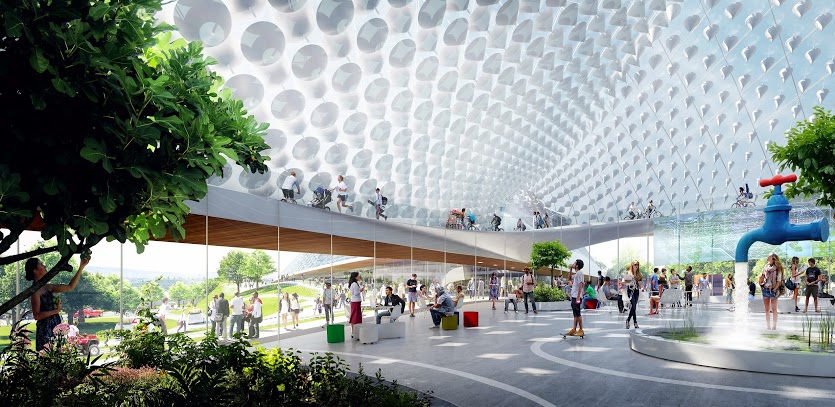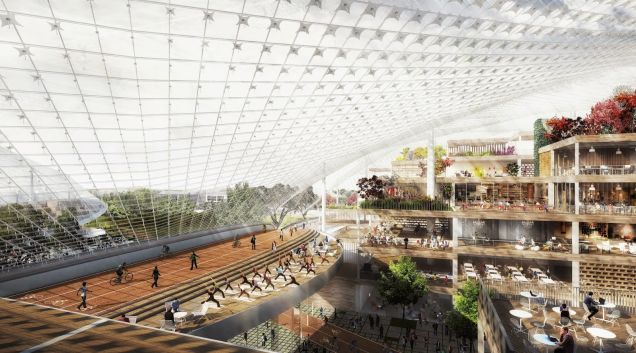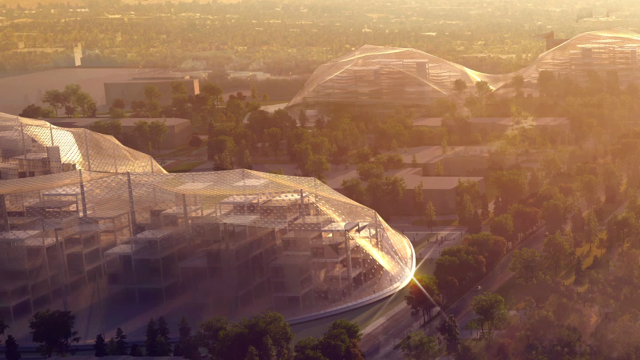Earlier today, we learnt that Google’s robot-built glass wonderland had been struck down by Mountain View’s City Council in favour of a plan by LinkedIn. Now, Bloomberg paints a picture of the plan that got shirked.
Yesterday Mountain View denied Google almost 80 per cent of the land it requested to develop — giving most of it to LinkedIn, which is building a mixed-use development with a main street and a movie theatre that the New York Times called “ambitious but not too ambitious” and “quite modest” in comparison with Google’s plan.
So what, exactly, is Google proposing? Bloomberg’s lengthy story about the design compares it to Google’s other “moon shots”, like Glass and internet balloons. What’s so moon shot-y about it?
Giant Glass Tents
One key element of the Bjarke Ingels and Thomas Heatherwick designed plan are the tent-like curtains that enclose the entire office in a micro-climate. These massive curtains will hang in tension from steel columns and be made up of thousands of glass pieces.

Bloomberg talks to several critics of the idea, who suggest that a) Mountain View has a perfect climate and creating a giant glass cocoon isn’t really necessary and b) those things are going to be a pain in the arse to clean.
However, this is not a new idea, architecturally speaking. The posthumous winner of this year’s Pritzker Prize, the German architect Frei Otto, pioneered tensioned structures in the 1950s and ’60s. It can certainly be done, and in some cases, can be less expensive and more quickly assembled than traditional structures.
Score: 2 out of 10 moon shots
Lego Offices
The offices and spaces inside are completely flexible — as the architects explain the structure will be modular and moveable, and spaces will be transformable according to need.

Bloomberg’s Brad Stone says that the idea sprang from Google’s desire to create an office like that of MIT’s famous Building 20, a prefab and temporary plywood building built during World War II that produced remarkable technological innovations long after it was torn down — in part, perhaps, because its easily-reconfigurable spaces.
While modular, transformable architecture isn’t a new idea — in fact it’s been around since the turn of the last century — structures that easily “plugin” and “unplug” hasn’t really been solved yet, at least cheaply. Stone points out that hooking up a particular module to the electrical grid will be a huge pain in and of itself.
So, who’s going to do all the work of hoisting, moving and re-attaching? Google is way ahead of you.
Score: 5 out of 10 moon shots
An Army of Crabots
“Crabot” is Google’s term for the robots that will populate the sprawling space — it’s a combination of “robot” and “crane.” These spidery robots will lift and move difference rooms and offices around the complex.
speaking of robotic reconfiguration, check out google’s #crabot http://t.co/MdFmsY2MxG via @petr_novikov pic.twitter.com/KzdymiB9zz
— Brian Ringley (@brianringley) April 26, 2015
These crabots don’t actually exist yet, however. “To accomplish this, Google says it will invent a kind of portable crane-robot, which it calls crabots, that will reconfigure these boxes and roam the premises like the droids in Star Wars,” writes Stone.
Maybe Google-owned Boston Dynamics can help, as Architect’s Journal recently suggested? Imagine sitting at your desk, looking out the window, and seeing an arm of Big Dog-esque robots scuttling around. Let’s not even imagine what happens if you get laid off.
Score: 9 out of 10 moon shots
Of course, Mountain View’s decision was about land use, not design. But Bloomberg’s entire design story is worth a read. Jokes aside, if Google develops the construction technologies that it says it will, it could be a major step forward for the design industry. In the meantime, there’s still a good chance these offices may be built — but just not where Google originally planned.
